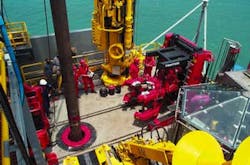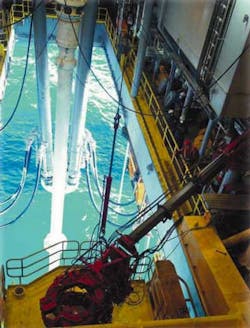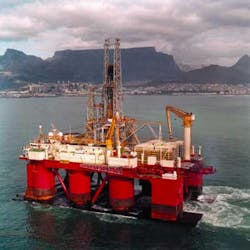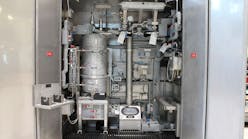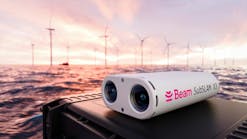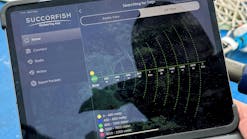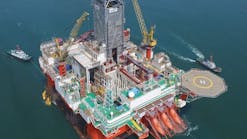DRILLING TECHNOLOGY: Customized mechanized rig systems allow offline stand-building of tubulars
Rail-mounted power tongs are used on the rig floor.
The past five years have brought trem-endous developments in mechanized rig systems that have spurred the imple-mentation of new technology as well as the adaptation of existing equipment. In turn, this has helped the industry achieve safety and productivity goals that previously were not possible. Weatherford is moving this new technology forward with pipe handling systems and equipment designs implemented on new-builds and upgrades, for deepwater drilling vessels as well as those for onshore use.
Additional technology is propelling rig mechanization systems forward in another way. We are finding methods to adapt these systems to fit the individual requirements of a job, which even further maximizes the operational efficiency of remotely controlled casing and tubing running operations. The following case history detailing the customized outfitting was developed in cooperation with the drilling contractor and operating companies for the deepwater Stena Tay vessel.
Stena Tay case
Specialized solutions were found and adapted on the Stena Tay in cooperation with the drilling contractor and operating companies to maximize operational efficiency of the remotely controlled casing and tubing running operations. Effective new drillships and semisubmersibles outfitted for deepwater operations are attractive in today's expanding deepwater market. - The setback area for the drill pipe, casing, and tubing stands is located down at the blowout preventer (BOP) deck level (cellar deck).
Although many of these new rigs have secured long-term contracts with operating companies, they may still be moved quickly between distant locations and/or be subcontracted for shorter periods to other operating companies. This high mobility of advanced rigs represents a potential challenge for service companies with regards to providing specialized equipment and sufficiently trained local expertise on short notice.
The fifth generation dynamically positioned semisubmersible Stena Tay (Stena Drilling) successfully drilled its first well in 3Q 1999 for Shell in Trinidad. The rig has since drilled four wells in Congo, West Africa, and three more wells off Brazil.
Although equipment from a multitude of vendors completes the drilling package design, Hydralift developed the general arrangement on Stena Tay. The rig features several unique designs. One of these is the use of hydraulic rams, instead of the traditional drawworks and traveling block in the derrick. Additionally, the setback area for the drill pipe, casing, and tubing stands is located down at the blowout preventer (BOP) deck level (cellar deck), while the rig floor is elevated to fingerboard level. This allows for opening and closing of elevators to always take place at rig floor level, while the arrangement provides an overall low center of gravity of the complete drilling package.
Dual activity option
The Stena Tay drilled its first well for Shell off Trinidad and is now drilling off Brazil.
Instead of using a dual activity rig floor, as many other new rig designs have chosen, Stena Tay has a separate standbuilding platform on the side. This enables offline standbuilding of tubulars without interfering with rig floor operations. Double stands of casing and triple stands of drill pipe are made up inside the standbuilding platform and racked back inside the setback area to be run later into the well from the rig floor.
In early 1999, a request was put out to provide equipment and personnel in Singapore to assist in commissioning the casing running and standbuilding capabilities of the rig. The casing tongs needed to come with integral backup in order to be able to make-up connections inside the standbuilding platform, and also to be remotely operated. This request presented the first challenge in the fact that the normal lead time for this type of equipment could not match the requested delivery. However, by diverting the necessary equipment partly from operations in Norway and partly from the production line in Germany, the equipment and personnel in Singapore were provided as requested.
The original design for the standbuilding platform was the installation of casing tongs inside a rail-mounted tong carrier in front of the hydraulic roughneck. During the commissioning, however, it was found that space restrictions made the installation and removal of tongs more time consuming than first expected. Although provisions could be made to improve this operation, alternative solutions were sought.
As is often the case, experience onsite is better than reading drawings in an office. What appeared impossible became possible when it was determined that a space inside the small derrick could accommodate the installation of a fixed suspension line for the remotely operated tongs. By mounting a small version of PowerScopetrademark (a telescopic tong manipulating device) in the corner of the standbuilding platform, and connecting this to the suspended power tongs, we could install and operate the tongs much more easily and quickly than with the initial rail mounted solution. Provisions were made to ensure that the interface with this smaller PowerScope would be the same as with the full-sized version that was recommended for use on the rig floor.
For various contractual reasons, the casing running contracts for Stena Tay have been individually tendered for the wells in Trinidad, Congo, and now Brazil. Remotely operated systems are available for rental, but are not yet ad hoc rental items in the industry.
As with any new technology, the goal is to train local expertise to handle that new technology. However, when a rig moves to a new area on short notice, there is often not enough time for local training. In the case of Stena Tay, these challenges became a strength.
A comprehensive equipment package has since been dedicated for this rig, replacing the units initially borrowed from our other mechanized operations. Today, the remotely-operated tong rental package is comprised of:
- PLC remote control system
- Remote tong manipulating device and pedestal for the rig floor
- Three mechanized casing tongs with free floating backup
- Mechanized tubing tong with integral free floating backup
- Hydraulic power unit.
Other handling equipment and services are also being provided.
Case summary
The ability to transfer equipment between locations and keep the same personnel onboard - in Trinidad, Congo, and now for an initial transition period in Brazil - has been helpful to both the drilling contractor and the operating companies. This ensured uninterrupted operations by personnel familiar with the rig and the mechanized equipment. However, the plan is to train and mix local Weatherford crews with the experienced operators from Trinidad, and over time, let these local crews take over and support the full-mechanized operation. This will help meet the nationalization requirement in Brazil and ensure safety during operations.
This case history illustrates some of the challenges that service companies and contractors continue to face when implementing new technology in an international market. Bringing service companies into the early planning stages of new-rig concepts can often benefit the drilling industry through implementation of new and emerging technologies, and may at the same time inspire the development of future products.
While it seems the solution to personnel issues is for the drilling contractor to purchase all of the new equipment, and have trained staff to operate everything, this may not be the case. This may be true for certain operations (tripping drill pipe) where the drill crew operates and services the equipment frequently enough to maintain continuously high levels of experience and competency.
However, other less frequently repeated and sometimes more challenging operations will still require assistance from service companies in order to ensure maximized up-time and safe operations, especially when implementing new technologies. The service companies must be prepared to train existing and new-hired personnel on new technologies to provide services across borders and international regions.
The drilling industry must continue to identify and take advantage of the possibilities of rig mechanization, and to continue adapting it to the existing drilling rig fleet. The results will be a cost effective approach that achieves safety and productivity goals.
Authors
Frank Mathews is Vice President and Egill Abrahamsen is Applications Engineer for Weatherford Rental and Well Installation Services.
Editor's Note: Stena Drilling provided for the inclusion of details of their operations in this article.

